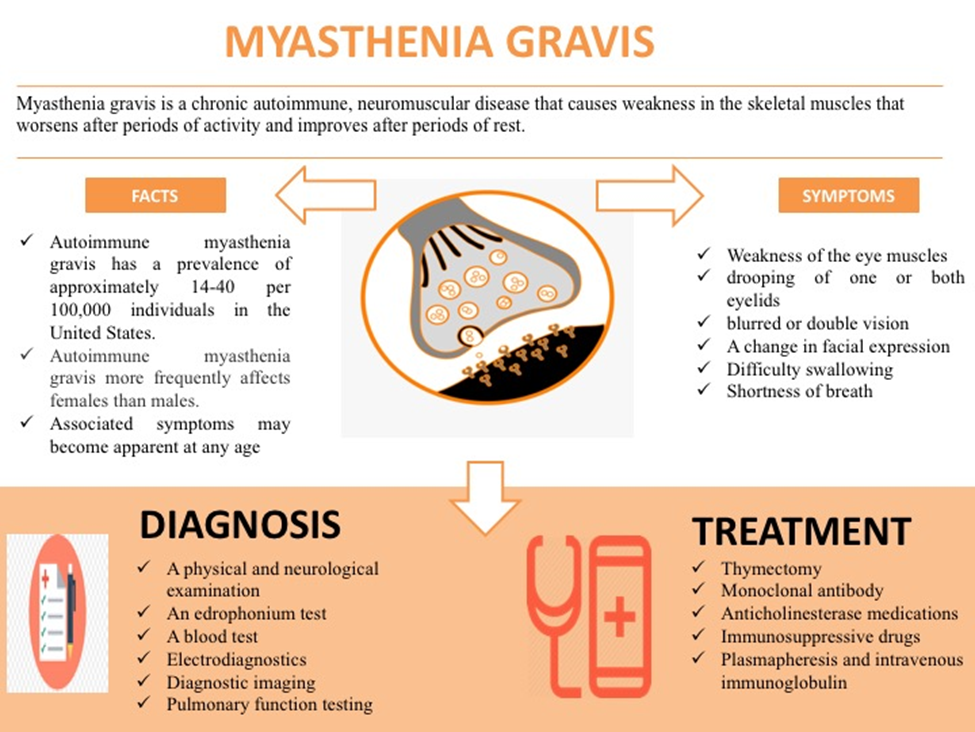A patient is receiving a dose of edrophonium. The nurse recognizes that this drug is given to determine the diagnosis of which disease?
Parkinson's disease
Alzheimer's disease
Myasthenia Gravis
Serotonin Syndrome
The Correct Answer is C
A. Parkinson's disease
Edrophonium is not used for the diagnosis of Parkinson's disease. Parkinson's disease is a neurodegenerative disorder characterized by motor symptoms such as tremors, rigidity, and bradykinesia. The diagnosis is typically based on clinical symptoms and neurological examination.
B. Alzheimer's disease
Edrophonium is not used for the diagnosis of Alzheimer's disease. Alzheimer's disease is a progressive neurodegenerative disorder affecting cognition. The diagnosis involves clinical evaluation, cognitive assessments, and sometimes imaging studies, but not the use of edrophonium.
C. Myasthenia Gravis
This is the correct choice. Edrophonium is used as a diagnostic tool in Myasthenia Gravis. In individuals with Myasthenia Gravis, the administration of edrophonium can lead to a temporary improvement in muscle strength, helping to confirm the diagnosis.
D. Serotonin Syndrome
Edrophonium is not used for the diagnosis of serotonin syndrome. Serotonin syndrome is a condition caused by an excess of serotonin, often due to the use of certain medications. Diagnosis is based on clinical symptoms and a history of serotonin-affecting medications, not the administration of edrophonium.

Nursing Test Bank
Naxlex Comprehensive Predictor Exams
Related Questions
Correct Answer is A
Explanation
A. Ephedra:
Ephedra is an herb that contains ephedrine, a stimulant known to cause symptoms such as severe headache, diaphoresis, and restlessness. Ephedrine has been associated with cardiovascular side effects, leading to its restriction or banning in many countries.
B. Feverfew:
Feverfew is an herb commonly used for migraine prevention. It is not typically associated with severe headache, diaphoresis, or restlessness. Instead, it is known for its potential benefits in reducing the frequency and severity of migraines.
C. Garlic:
Garlic is an herb often used for various health purposes, including cardiovascular health. It is not known to cause severe headache, diaphoresis, or restlessness.
D. St. John's Wort:
St. John's Wort is an herb commonly used for mood-related conditions, such as mild to moderate depression. It is not associated with the symptoms described, and its primary effects are related to mood regulation.
Correct Answer is ["125"]
Explanation
`To calculate the rate of infusion in mL/h, you need to divide the total volume of fluid by the total time of infusion.
In this case, you have 1,000 mL of normal saline (NS) to infuse in eight hours.
Therefore, the rate of infusion is 1,000 mL / 8 h = 125 mL/h.
Whether you are a student looking to ace your exams or a practicing nurse seeking to enhance your expertise , our nursing education contents will empower you with the confidence and competence to make a difference in the lives of patients and become a respected leader in the healthcare field.
Visit Naxlex, invest in your future and unlock endless possibilities with our unparalleled nursing education contents today
Report Wrong Answer on the Current Question
Do you disagree with the answer? If yes, what is your expected answer? Explain.
Kindly be descriptive with the issue you are facing.
